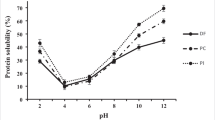Abstract
The physicochemical and functional properties of seinat seed flour (SSF), defatted seinat flour (DSSF), and protein isolates were studied. Protein was extracted from DSSF using an alkali solution with isoelectric precipitation and freeze drying. Freeze dried seinat seed protein isolates (FSSPI), SSF, and DSSF were evaluated for their physicochemical and functional properties. SSF contained high levels of crude fat and fiber (31.13% and 24.75%, respectively). FSSPI contained 91.83% protein versus 28.58% for SSF. The amounts of potassium, the mineral with the highest content, were 9,548.33, 6,439.03, and 1,029 mg/100 g in SSF, DSSF, and FSSPI, respectively. The functional properties were variable among samples. The protein solubility of FSSPI was significantly higher (p<0.05) than for DSSF and SSF. FSSPI has a significantly better (p<0.05) foaming capacity, water/fat absorption capacity, and bulk density than SSF and DSSF. FSSPI also showed an emulsifying capacity comparable to commercial soy protein isolates.
Similar content being viewed by others
References
Jeffrey C. Appendix: An outline classification of the Cucurbitaceae. In: Biology and Utilization of the Cucurbitaceae. Bates DM, Robinson RW, Jeffrey C (eds). Comstock, Cornell University Press, Ithaca, NY, USA. pp. 449–463 (1990)
Badifu GIO. Effect of processing on proximate composition, antinutritional and toxic contents of kernels from Cucurbitaceae species grown in Nigeria. J. Food Comps. Anal. 14: 153–161 (2001)
AL-Khalifa AS. Physicochemical characteristics, fatty acid composition, and lipoxygenase activity of crude pumpkin and melon seed oils. J. Agr. Food Chem. 44: 964–966 (1996)
Mohamed EI, Pitrat M. Tibish, a melon type from Sudan. Cucurbit genetics cooperative report 22: 21–23. Available from: http://cuke.hort.ncsu.edu/cgc/cgc22/cgc22-9.html. Accessed Dec. 13, 2012.
Ali AM. Sudan’s 4th national report to the convention on biological diversity. The Higher Council for Environment and Natural Resources (HCENR), Khartoum, Sudan. Available from: http://www.cbd.int/doc/world/sd/sd-nr-04-en.pdf. Accessed Nov. 18, 2012.
El-Adawy TA, Taha KM. Characteristics and composition of different seed oil and flour. Food Chem. 74: 47–54 (2001)
Yuan, DB, Yang XQ, Tang C-H, Zheng ZX, Ahmad I, WM, Yin SW. Physicochemical and functional properties of acidic and basic polypeptides of soy glycinin. Food Res. Int. 42: 700–706 (2009)
Rezig L, Chouaibi M, Msaada K, Hamdi S. Chemical composition and profile characterization of pumpkin (Cucurbita maxima) seed oil. Ind. Crop Prod. 37: 82–87 (2012)
Meng GT, Ching KM, Ma CY. Thermal aggregation of globulin from an indigenous Chinese legume (Phaseolus angularis) red bean. Food Chem. 79: 93–103 (2002)
Laemmli UK. Cleavage of structural proteins during the assembly of the head of bacteriophage T4. Nature 227: 680–685 (1970)
AOAC. Official Methods of Analysis of the AOAC, 15th ed. Methods 932.06, 925.09, 985.29, 923.03. Association of Official Analytical Chemists, Arlington, VA, USA (1990)
James CS. Analytical Chemistry of Foods. Chapman and Hall, New York, NY, USA. pp. 56–58 (1996)
Clark EP, Collip JB. A study of the Tisdall method for the determination of blood calcium with a suggested modification. J. Biol. Chem. 63: 461–464 (1995)
AOAC. Official Methods of Analysis of the AOAC international, 16th ed. Method 970.12. Association of Official Analytical Chemists International, Washington, DC, USA (1995)
Ranganna S. Handbook of Analysis and Quality Control for Fruit and Vegetable Products. Tata McGraw-Hill Publishing Company, New Delhi, India. pp. 124–125 (1986)
Tang C, Wang X. Physicochemical and structural characterisation of globulin and albumin from common buckwheat (Fagopyrum esculentum Moench) seed. Food Chem. 121: 119–126 (2010)
Ogunwolu SO, Henshaw FO, Mock H, Santros A, Awonorin SO. Functional properties of protein concentrates and isolates produced from cashew nut. (Anacardium occidentale L.). Food Chem. 115: 852–858 (2009)
Mariod AA, Ahmed YM, Matthaus B, Khaleel G, Siddig A, Gabra AM, Abdelwahab SI. Comparative study of the properties of six Sudanese cucurbit seed and seed oils. J. Am. Oil Chem. Soc. 86: 1181–1188 (2009)
Marcone MR, Kakuda Y, Jahaniaval F, Yada RY, Montevirgen LS. Characterization of the proteins of Pili nut (Canarium ovatum, Engl.). Plant Food. Hum. Nutr. 57: 107–120 (2002)
Wu H, Wang Q, Ma T, Ren J. Comparative studies on the functional properties of various proteins concentrates preparations of peanut protein. Food Res. Int. 42: 343–348 (2009)
Nyam KL, Tan CP, Lai OM, Long K, Mana CYB. Physicochemical properties and bioactive compounds of selected seed oils. Food Sci. Technol. 42: 1396–1403 (2009)
Adelakun OE, Ade-Omowaye BIO, Adeyemi IA, Venter M. Mineral composition and the functional attributes of Nigerian okra seed (Abelmoschus esculentus Moench) flour. Food Res. Int. 47: 348–352 (2012)
Akwaowo EU, Ndon BA, Etuk EU. Minerals and antinutrients in fluted pumpkin (Telfairia occidentalis Hook f.). Food Chem. 70: 235–240 (2000)
Galla NR, Dubasi GR. Chemical and functional characterization of Gum karaya (Sterculia urens L.) seed meal. Food Hydrocolloid. 24: 479–485 (2010)
FAO. Protein and Amino Acid Requirements in Human Nutrition. Report of a joint WHO/FAO/UNU Expert Consultation. WHO technical Report Series, 935. FAO, Geneva, Switzerland (2007)
Ragab DM, Babiker EE, Eltinay AH. Fractionation, solubility and functional properties of cowpea (Vigna unguiculata) proteins as affected by pH and/or salt concentration. Food Chem. 84: 207–212 (2004)
Mahajan A, Bhardwaj S, Dua S. Traditional processing treatments as a promising approach to enhance the functional properties of rapeseed (Brassica campestris var. toria) and sesame seed (Sesamun indicum) meals. J. Agr. Food Chem. 47: 3093–3098 (1999)
Pednekar M, Das AK, Rajalakshmi V, Sharma A. Radiation processing and functional properties of soybean Glycine max. Rad. Phys. Chem. 79: 490–494 (2010)
Moure A, Sineiro J, Dominguez H, Parajo JC. Functionality of oilseed protein products: A review. Food Res. Int. 39: 945–963 (2006)
Amadou I, Amza T, Foh MBK, Kamara MT, Guo-Wei L. Influence of Lactobacillus plantarum Lp6 fermentation on the functional properties of soybean protein meal. Emirates J. Food Agr. 22: 456–465 (2010)
Author information
Authors and Affiliations
Corresponding author
Rights and permissions
About this article
Cite this article
Siddeeg, A., Xu, Y., Jiang, Q. et al. Physicochemical and functional properties of flour and protein isolates extracted from seinat (Cucumis melo var. tibish) seeds. Food Sci Biotechnol 23, 345–353 (2014). https://doi.org/10.1007/s10068-014-0048-x
Received:
Revised:
Accepted:
Published:
Issue Date:
DOI: https://doi.org/10.1007/s10068-014-0048-x




